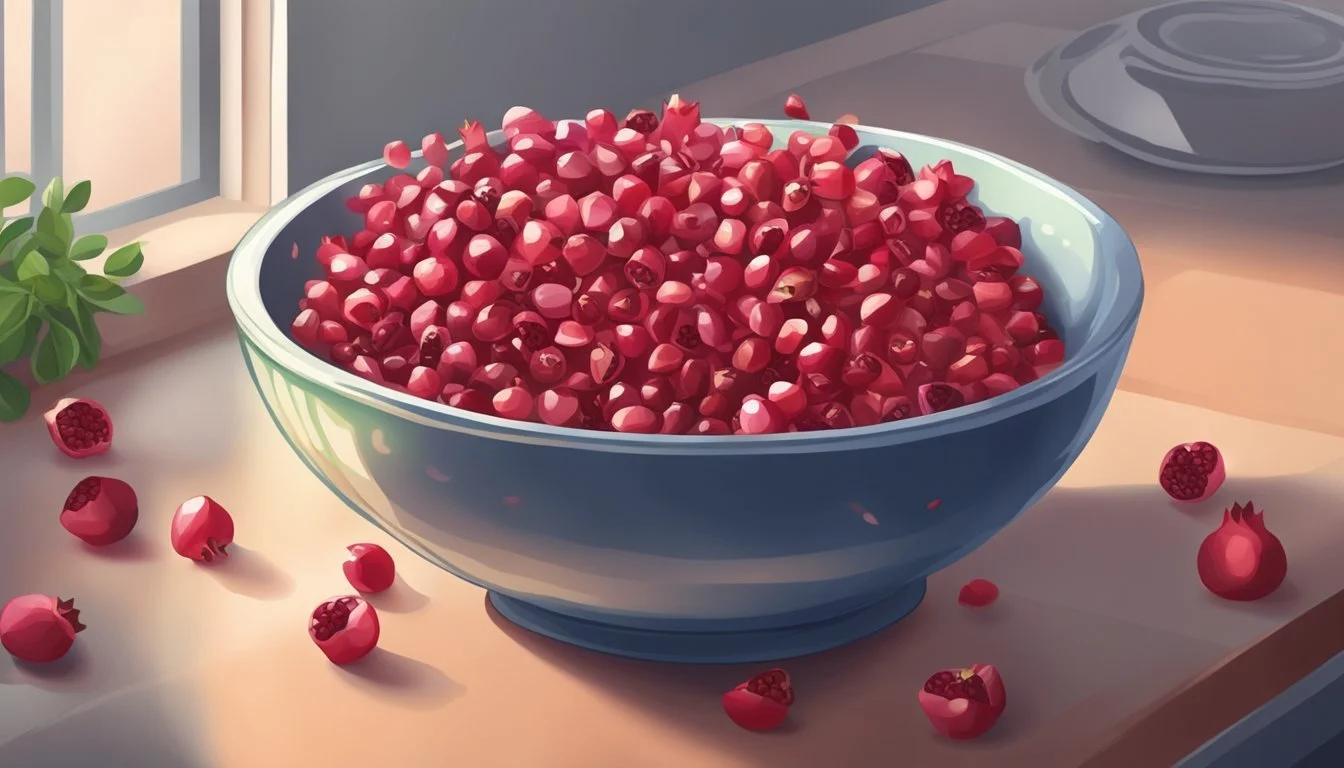How Long Do Pomegranate Seeds Last?
Shelf Life and Storage Tips
Pomegranate seeds (how long do seeds last?) are known for their vibrant color, juicy burst of flavor, and numerous health benefits, making them a popular addition to a variety of culinary concoctions. Their shelf life, however, is determined by how they are stored. Generally, pomegranate seeds have a relatively stable shelf life compared to other fruit seeds. When stored properly under the right conditions, they can maintain quality over an extended period.
In the refrigerator, pomegranate seeds can last for about 4 to 6 days. For those looking to store pomegranate seeds for several months, proper storage is key to preserving their freshness. It involves keeping them in an airtight container and refrigerating them, which can significantly extend their usability, keeping them crunchy and flavorful. It's important to note that the seeds' longevity also depends on the freshness of the pomegranate from which they were extracted.
Pomegranate Overview
Pomegranates are known for their deep red, jewel-like seeds called arils, which offer a unique sweet and tangy flavor and a crunchy texture. These seeds are edible, valued not only for their taste but also for their impressive nutritional benefits.
Nutritional Profile
Pomegranate seeds are a rich source of fiber, vitamins, and antioxidants. They provide vitamin C, vitamin K, and potassium, among other nutrients. The seeds' high antioxidant content contributes to their reputation as a healthful food. A typical serving of pomegranate arils can contain:
Fiber: 3.5 g
Vitamins: Vitamin C (9% DV), Vitamin K (16% DV)
Antioxidants: Punicalagins and anthocyanins
Selection and Freshness
Selecting a ripe pomegranate is key to enjoying its quality and freshness. A ripe pomegranate should be firm, heavy for its size, and have a bright, deep red exterior. The skin may appear slightly cracked, indicating ripeness. The fresher the pomegranate, the longer its seeds will last after being harvested.
Pomegranate Seed Anatomy
Each pomegranate contains hundreds of arils, which are the edible seeds surrounded by a water-laden sac, responsible for their juicy burst of flavor. The seeds' firmness contributes to their crunch, and they are enveloped by the sweet and tangy juice that characterizes the appealing taste of pomegranate.
Storage Fundamentals
Storing pomegranate seeds correctly ensures they retain freshness and taste for as long as possible. Proper storage methods can prevent spoilage and maintain their quality and safety for consumption.
Ideal Storage Conditions
Pomegranate seeds last the longest when stored in a cool, dark place away from direct sunlight. They should be kept in an airtight container to protect them from moisture and other contaminants.
Temperature: Keep seeds in the refrigerator, ideally between 32°F to 40°F (0°C to 4°C).
Location: Store in a less-humid part of the fridge, such as the crisper drawer, to avoid excess moisture.
Extending Shelf Life
For longer storage, freezing pomegranate seeds is a viable option:
Preparation: Spread seeds in a single layer on a baking sheet lined with parchment, and freeze until solid.
Storage: Transfer frozen seeds to a sealable freezer bag or an airtight container suitable for freezing.
Thawing: When ready to use, thaw the seeds in the refrigerator to maintain their structural integrity.
Freezing can extend the shelf life up to 6 months.
Signs of Spoilage
Be vigilant for any signs that pomegranate seeds are no longer safe to eat:
Mold: Visible fuzzy or colored growth.
Texture: Seeds shouldn't be slimy or overly soft.
Smell: An off or sour smell indicates that the seeds may be bad.
Food Safety Considerations
When storing pomegranate seeds, it's crucial to maintain cleanliness to prevent foodborne illness:
Before storing, ensure hands and all surfaces the seeds come into contact with are clean.
Regularly check seeds for spoilage, and dispose of any that show signs of mold or bacteria growth.
Avoid cross-contamination by keeping seeds away from raw meats and unwashed produce.
Practical Usage
This section explores the versatile nature of pomegranate seeds in culinary settings and the various methods for incorporating them into everyday meals. It offers concrete examples of their use in recipes and how to prepare them for maximum flavor.
Culinary Applications
Pomegranate seeds' sweet and tart flavor profile makes them a popular addition to a variety of dishes. These ruby-like morsels add a burst of flavor and nutrition to both sweet and savory preparations. Fresh pomegranate seeds bring not only a vibrant color but also a rich source of fiber and antioxidants to meals.
Incorporating into Meals
Pomegranate seeds are commonly eaten raw and can serve as a nutritious snack. They are also a delightful topping that can be sprinkled over salads to lend a tangy taste or mixed into yogurt and oatmeal for breakfast. For a light yet satisfying option, combining pomegranate seeds with smoothies offers a refreshing treat.
Creative Ideas
Desserts: Incorporate them into desserts for a sweet, yet tangy flavor.
Cocktails: Jazz up beverages and cocktails with a spoonful of seeds for visual appeal and taste.
Yogurt Parfaits: Layer them in yogurt parfaits for texture contrast and a punch of flavor.
Salad Insert: Enrich salads with their juicy crunch for added complexity in each bite.
Preparation Techniques
To extract seeds from a ripe pomegranate, cut the crown off the fruit, score it into sections, then break it apart in a bowl of water; the seeds sink while the membrane floats. Tapping the back of the fruit with a wooden spoon over a baking sheet is another popular method. Whether using in cooking or as a standalone snack, proper preparation can heighten the sensory experience of pomegranate seeds.
Optimal Storage Techniques
Proper storage is crucial for maintaining the texture, flavor, and color of pomegranate seeds. The following techniques ensure the seeds stay fresher for longer, whether stored in the fridge, the freezer, or at room temperature.
Refrigeration Tips
Texture & Flavor Preservation: Store pomegranate seeds in the fridge in an airtight container or a resealable bag to maintain their juiciness and prevent flavor loss.
Duration: Pomegranate seeds typically last about 1-2 weeks in the fridge when stored correctly.
Visibility: Use clear containers and label with the date to keep track of freshness.
Freezer Guidelines
Texture Retention: For extended shelf life, freezing is advised. Frozen seeds can have a slightly altered texture but retain most of their flavor and nutritional value.
Procedure:
Dry the seeds thoroughly before freezing to prevent ice crystal formation.
Spread them out on a baking sheet to freeze individually before transferring to a freezer-safe, airtight container.
Shelf Life: Properly frozen seeds can last up to 6 months while maintaining quality.
At Room Temperature
Short-Term Option: Pomegranate seeds can be kept at room temperature in a cool, dark place if they will be consumed quickly.
Expectations:
The seeds can last a day or two without notable changes to their smell or color.
They are more susceptible to drying out or becoming soft, impacting texture and flavor.
Handling and Preservation
When preserving pomegranate seeds, one's primary goal is to maintain their freshness and prevent oxidation. Proper handling techniques can significantly extend the shelf life while preserving the seeds' texture and nutrient content.
Preventing Oxidation
To prevent the oxidation of pomegranate seeds, which can affect their color and freshness, it's essential to store them in a way that minimizes their exposure to air. Using an airtight container is critical in combating the oxidative process. Additionally, for short-term storage, placing pomegranate seeds in a plastic bag with as much air removed as possible can also help retain their vibrant color and juicy texture.
Antioxidants within the seeds can fend off oxidation to some degree, but proper storage measures are vital to preserve these natural defenses. Incorporating these practices will help in keeping the seeds as fresh and vibrant as when they were first harvested.
Ensuring Freshness
To ensure maximum freshness, pomegranate seeds should be stored in the refrigerator where they can remain hydrated and juicy. The ideal storage conditions involve:
Temperature: Keep seeds at a consistent, cool temperature.
Humidity: A moderate level of humidity helps keep seeds plump.
Container: Use of an airtight container to protect from external odors.
It's important that the seeds remain dry and are not washed prior to storage as excess moisture can lead to a degradation in texture and could increase the likelihood of spoilage. Properly stored, pomegranate seeds can stay fresh for up to two weeks in the refrigerator.
Health and Nutrition
Pomegranate seeds, when fresh and ripe, offer a bounty of nutrients that can contribute to overall wellness. These seeds are not just a flavorful addition to one's diet but are packed with valuable constituents that support health.
Nutritional Value
Fresh pomegranate seeds are a rich source of dietary fiber, vitamins, and minerals. Specifically, half a cup of pomegranate seeds contains the following:
Vitamin C: Essential for immune system function.
Vitamin K: Important for blood clotting and bone health.
Potassium: Vital for heart function and muscle contractions.
Folate: Necessary for DNA synthesis and repair.
They also provide a modest calorie count, making them a nutrient-dense snack option.
Benefits for Wellness
Antioxidants are abundant in pomegranate seeds, specifically punicalagins and anthocyanins, which may have anti-inflammatory properties. The nutritional benefits of these seeds contribute to:
Heart Health: Antioxidants in pomegranate seeds can help reduce blood pressure and lower the risk of cardiovascular diseases.
Fiber Content: High fiber in the seeds aids in digestion and may contribute to maintaining a healthy weight.
Regular consumption of pomegranate seeds, as part of a balanced diet, can be a powerful addition to one's nutritional regime, offering multiple wellness benefits.
Identifying Quality
When selecting pomegranate seeds, one should look for indicators of peak ripeness and absence of defects. Sensory evaluation methods can help discern the suitability of seeds for consumption, focusing on color, texture, and taste.
Assessing Ripeness
Ripe pomegranate seeds exhibit a bright red to deep ruby color, indicating they are ready to be consumed. The seeds should be firm to the touch, which is a telltale sign of their freshness and ripeness.
Checking for Defects
It is critical to inspect pomegranate seeds for any soft spots, damage, or mold. Seeds should be free from cuts, which could accelerate spoilage. Pomegranate seeds affected by mold, particularly those where the mold is not visible, should be discarded as mold can easily spread throughout the moist fruit.
Sensory Evaluation
One should perform a sensory evaluation by sampling a few seeds. They should be tangy and tart yet retain a slight sweetness, which is characteristic of a flavorful and fresh pomegranate seed. The texture is ideally crunchy, not soggy or overly soft, preserving the sensory experience which is essential for culinary applications.
Conclusion
Pomegranate seeds can have varying lifespans depending on their storage conditions. Once opened, the seeds typically last on the counter for 1 to 2 days and in the fridge for 4 to 6 days. For optimal preservation, one should store pomegranate seeds in the fridge where the cold temperature retains their natural moisture and juiciness.
Storing Pomegranate Seeds:
Countertop: Short-term option (1-2 days).
Refrigerator: Best option (4-6 days).
Freezer: Long-term option (extended period).
For those who plan to consume pomegranate seeds within a few days, refrigeration is the best way to maintain their quality and extend shelf life. The key is to ensure that the seeds are stored in airtight containers or sealed bags to protect them from moisture and other contaminants.
In the freezer, pomegranate seeds can last for a more extended period when stored correctly, though it is important to note that texture and taste might be slightly altered upon thawing. Freezing them in single layers on a baking sheet before transferring to containers or bags can prevent clumping, making it easier to use small amounts as needed.
Remember, signs of spoilage include brown, mushy seeds and an off scent. Regular checks for these signs can prevent one from consuming seeds that have gone bad. By following proper storage procedures, individuals can enjoy the tart and tangy taste of pomegranate seeds while minimizing waste.







